Minding Your Dreams
Welcome to Creative Conversations–discussions about the creative process. Today Janet talks with award-winning author, and emerging sculptor, Dia Calhoun.
 Taken on The Bridge of Glass outside the Museum of Glass in Tacoma
Taken on The Bridge of Glass outside the Museum of Glass in Tacoma
 Dia’s books
Dia’s books
Janet: Hi Dia. We’ve talked a lot about the creative process over the years, and it’s always interesting to hear your ideas. What would you like to focus on today?
Dia: Hi Janet. Thank you for having me on Creative Conversations. I’d like to talk about Minding Your Dreams. That’s different from mining them.
Janet: Okay, I’m already curious to hear how it’s different and why. So, shoot.
Dia: The first thing to understand is that the unconscious is a separate and autonomous part of the self. The conscious mind does not entirely run the show. So to “mine” the unconscious is exploitative in a way, to me. Minding your dreams means having a relationship with an equal.
Janet: I see how that’s more respectful. I know dreams play a big part in my writing process. Can you give any examples of how minding your dreams led you to somewhere interesting?
Dia: Minding your dreams means you’re paying sustained attention to them over a long period of time. That means recording them and thinking about them, or making art from them. Two things happen as a result. First, you develop an active relationship with your dreams/unconscious. The conscious and unconscious start talking to each other through the bridge of symbols. Over time, themes, characters, and narratives develop. It does take some study to learn how to interpret your dreams. Study of how the psyche works and of how symbols function in religion, mythology and fairy tales. The second thing that happens as a result of all this is that the writer/artist develops her “symbolic muscles” so to speak. Your symbolic thinking gets richer and deeper than it was before. So, that improves your writing, etc.
Janet: That sounds exciting! If it’s alright, I’d like to notice that I communicate and listen to my inner storyteller sometimes through daydreams, and sometimes I “hear from her” when I’m deeply still and meditating. There’s a kind of transcendental meeting place where images or words flow. Is it like that for you?
Dia: I understand what you mean. What happens to me that is similar is a state I call Creative Drift. It usually has to do with the motion of body and stillness of mind. Say swinging in my hammock for instance. I enter that semi-conscious gate between consciousness and the unconscious. And many images or ideas flow from there.
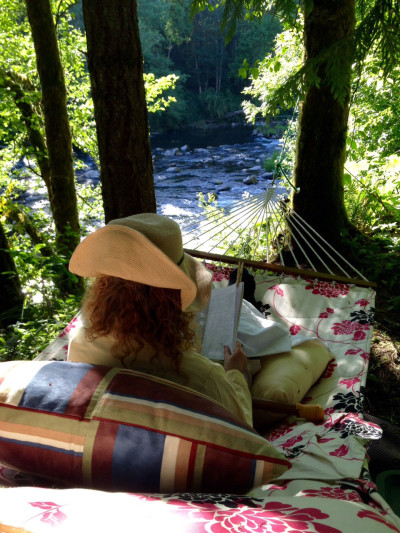
Janet: Beautiful! I’d also like to give a specific example of entering the semi-conscious gate. Near the end of In The Time of Dragon Moon, I wrote an intuitive scene where Uma and Jackrun travel under a volcano and find “the ash child.” There was death and rebirth in this scene that ultimately had to be cut entirely out of the book, but I knew my dream images were speaking with the ash child. I knew she had things to say to me and it was time to watch and wait and listen to her. The scene came first as a daydream, and when it happens that way, the words come out almost like music.
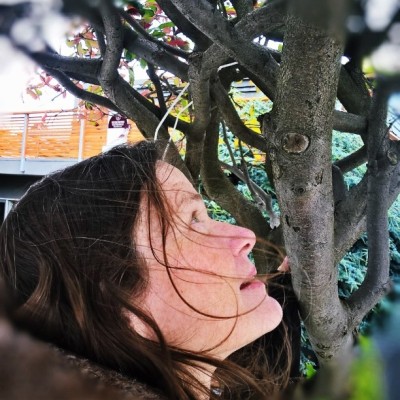
Dia: That’s beautiful. And it is often true that the words or images that emerge from that semi-conscious state are like arrows shot from a bow–true and flashing and right on target. Have you ever read about Carl Jung’s concept of the transcendent function?
Janet: Wait! The synchronicity of your mentioning arrows/bows is mind-blowing since I just turned in a piece today for PNWA and likened writing to archery using similar symbols. You and I get on the same symbolic page without even trying, Dia.
 I’ve read some Carl Jung, but refresh me.
I’ve read some Carl Jung, but refresh me.
Dia: Yes, we are on the same page! That’s because we both work with the understanding of the numinosity of archetypes. As for the transcendent function, this is a quick definition, but when the conscious and unconscious minds begin working together, usually to solve some problem that seems unsolvable, a third thing is created, usually a symbol. That symbol making function is called the transcendent function. It is often symbolized in dreams by images of marriage. Another name for it is Hieros Gamos–sacred wedding. It symbolizes the union between the conscious and unconscious minds.
I began dreaming about weddings and especially wedding cakes about a year ago. So, I decided to explore that in my sculptural work, in a piece called Hieros Gamos.
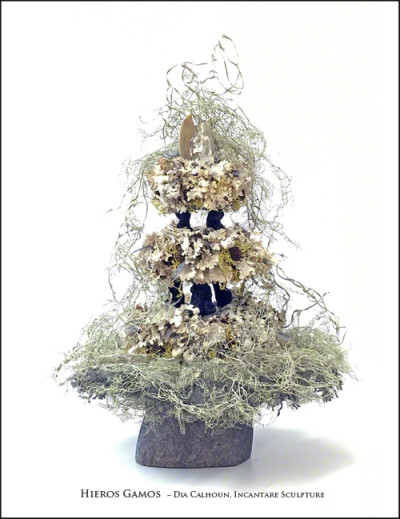
Janet: I love the idea of the transcendent function. And what a beautiful sculpture, Dia! You’ve had tremendous creative energy lately.
Dia: Ever since I started minding my dreams, my life has changed. I’ve had an explosion of creativity. I started writing picture books from dreams and dream images. I found I loved being able to see an entire story in 500-800 words. One of my picture book manuscripts suggested itself as an early middle-grade fantasy novel. And now I’m deep in that, and writing in a different way than ever before.
I found I had to see the entire story–the picture books had spoiled me. So, I wrote the novel draft straight through. But along the way, I made extensive notations in Word comments on the side of the manuscript. As I learned something new about the story, instead of rewriting chapters, I just made a note in the comment to incorporate the change. Then I wrote forward in the story forward as though I had already made the changes in the manuscript. This was an amazing new way for me to work. I’m currently 25% through the second draft, and because I know the whole story, I’m actually POLISHING in the second draft.
Janet: Some of my fantasy novels began as fairytales that kept expanding. Perhaps that’s a bit like your discovery, but I do share the chapters with my critique group as I’m writing. It’s very helpful in many ways, but sometimes it can subtly change the momentum.
Dia: I also share chapters with my critique group as I go. But instead of immediately rewriting based on their suggestions, I put the comments in the comment notes. Then I write forward with any changes I was going to make in mind. The operative term is “Write Forward.”
Janet: Yes! Another danger of sharing too soon is that sometimes my subconscious mind will throw something puzzling into the draft. I have no idea what it’s doing there, but I don’t cut it out to make the story more logical or sensible. I leave it in place. When I’ve done that, I sometimes discover that illogical piece is key to something big for the novel or for a particular character. Critique comes from a left brain “how do you explain this?” sort of place. I need to trust the unexplainable and let the dream-draft speak. Do you know what I mean about the early feedback dangers?
Dia: Yes, and it takes strength to keep on your path. You are honoring the process of mystery.
Janet: I have to be strong to honor the process of the mystery. I need to hold my ground when things feel messy. I have to admit that it’s a challenge.
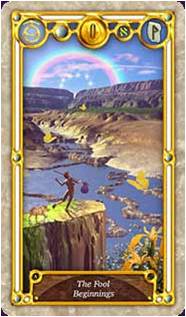
When things are uncertain, part of me thrilled at the dizzying view! Part of me is thinking — you’re just about to step off this cliff, you Fool!
Dia: We aren’t trained to tolerate uncertainty. We live in a rationalistic world that wants to know exactly what a thing is right now, and where it will lead. We have to learn the value of holding uncertainty, and of bearing the discomfort of that in order to let things unfold. It’s difficult, but it’s a good and whole way to live. I’ve been doing that for the past three years since I began working with my dreams. And that has changed the way I live.
Janet: I’ve seen the transformation, Dia. You’ve moved to a beautiful place by a river. You are vibrant and alive. You’re doing many kinds of art. This culture is into “communication” via the internet and phones. But the communication you’re talking about here (the “Hieros Gamos” sacred wedding) is internal. A way of listening to what your deeper self is experiencing and how you’re translating the world. I practice Christian meditation using an ancient mantra to stay in touch in that way. I need to create a sacred space, turn off the blaring messages coming from all directions, get quiet and listen to God, and to my soul.
Dia: Yes. The idea is to walk through the world with all parts of yourself in accordance: conscious self, unconscious self, and the greater Self that contains them both. Jung calls this process individuation. Paradoxically, the more you communicate in this inner way, the more you connect and communicate with the larger human world. I’d like to offer a tip on recording dreams if I may?
Janet: Sure!
Dia: When you wake up in the morning, speak your dreams into the note-taking function in your phone instead of trying to write them down. It’s faster and more effective. Mumbling the dreams, you can stop and start. Ramble. You can say, oh, wait! Now I remember this part came before that part . . . etc. As I speak, I recall more and more. The mechanics of writing, on the other hand, retards the dream memory.
Every morning, I thank my unconscious for sending the dreams, be they beautiful or terrible. Whatever relationship you hold toward your unconscious, it will hold toward you. This brings us back to the idea of Minding Your Dreams. The unconscious is a huge, autonomous part of ourself and it’s disrespectful to ignore it. For more on working with dreams, I also recommend Encounters with the Soul: Active Imagination as developed by C.G. Jung by Barbara Hannah. And for understanding the symbol making function, author Marie Louise von Franz. And of course, Carl Jung.
Janet: Cool! I can see how talking them out is more fluid. Sometimes writing can invite the interpreter in too soon, leaving out the “odd bits” as Monty Python would say, demanding it to be more linear, and so on. I see how that would be the best way. But I also know the process of writing with the fingers seems to also connect to the subconscious for me. Words that flow from my fingers– from silence– sometimes surprise me, being more subtle expressions than I can voice.
Dia: Yes. Recording dreams is about memory-retrieval. Writing with a pencil definitely helps me connect with my unconscious, too, but it’s a more creative process.
You asked for an example of how a dream turned into a sculpture. So, let me share the story of The Green Shoe. First, I’ll share the dream, which I had on December 21, 2014. In the dream, I went into a room to pick up my belongings. A woman told me that former friends had already picked up theirs and taken them away, and what had taken me so long? I packed my things because they didn’t fit anymore.
Then the room turned into a thrift shop full of books, clothes, and shoes. I spotted a pair of green shoes. They were lace-up shoes, trail shoes or running shoes with good, sturdy soles. I tried one on, and to my surprise, it fit me perfectly. I turned to the woman and said, “They fit me perfectly! Nothing ever fits me; I have short, wide feet.” (Size 5W) I loved the green color. I decided to take the shoes because they fit me perfectly.
Three weeks later, in waking life, I went to Goodwill to look for a wool shirt. (I had forgotten about the dream.) The store had been remodeled. I passed the shoe section, which had been moved and redone. I hadn’t come to look for shoes, but needed some good waterproof shoes, because we had just bought our house on three acres on the Nisqually River. So, I veered into the shoe section. I found the size five section, scanned the shelves, and pulled out a pair that looked sturdy and waterproof. I put them on. To my surprise, they fit me perfectly. As that thought flooded my mind, I stared down at them. Then, and only then, did I realize the shoes were green! I stood stunned as the dream I’d had three weeks earlier flashed into my mind.

This is what Carl Jung calls synchronicity.
I knew this was important. I researched the symbolic meaning of shoes in stories and tales. Shoes represent our agency in life, our grounding, how we walk through the world. Sturdy green shoes do fit me perfectly. I am most alive, most authentically myself, when I’m tramping through the woods and fields.
I continued exploring the image of the green shoes. I wrote a picture book manuscript called the Green Shoes which I love and hope to publish. I also made a sculptural piece called the Green Shoe.
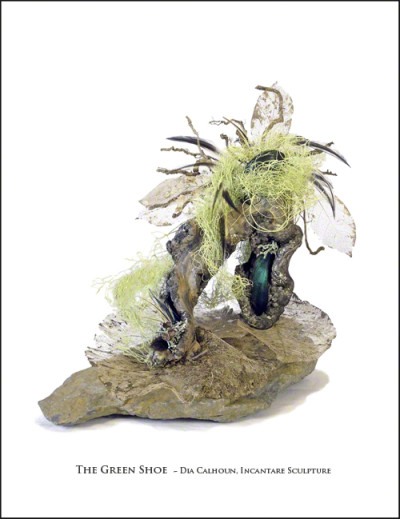
And I named my studio building here on the Nisqually River, the Green Shoe. My life and work do fit me perfectly! This shows how a symbol carries numinous energy when you work with it. Working with dreams brings the conscious mind and unconscious mind into confluence. And when that happens, life begins to flow.
Janet: Dia thanks for this conversation on Minding Your Dreams.
Dreamwalkers, I hope your life and your work come to fit you perfectly.

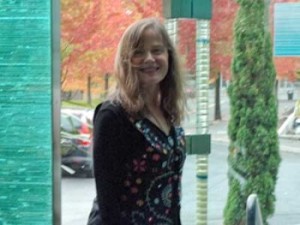



Hi Janet,
Thank you so much for including me in this series of fascinating blog posts.
It was a blast talking with you Dia. I’ve had so many vivid dreams since we talked!
Loving this inspirational conversation, ladies. Synchronicity is such a powerful force, and what an exciting creative stage you’re in, Dia. (That sculpture is amazing!) I pay attention to synchronous signs and frequently record them — but it’s been a long time since I’ve recorded dreams. I love the minding vs. mining take!
The minding vs. mining was a new take for me, too, Lisa. I’m interested to hear that you also pay attention to “synchronous signs”
You are both so inspiring. I have run into some of synchronicity at times, but I wonder if I put enough attention to my dreams. Thank you for sharing your thoughts. M.